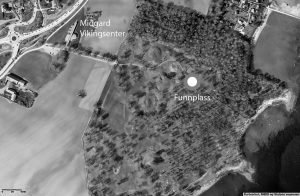Archaeologists have discovered a “unique” Viking ship buried in a field that appears to be the final resting place of a famous warrior who will now be dining in Odin’s Hall in Valhalla.
Ship burials were a special ritual for important people such as great warriors or kings and in Norse mythology they represent safe passage into Valhalla – the Viking afterlife.
The discovery took place near the Borre Park, the largest burial mound site in northern Europe, in the town of Horten in the southern Norwegian county of Vestfold.
According to local media, scientists first believed that they had discovered the long ship two years ago, but they needed the latest geo-radar technology to confirm the find.
Norwegian Minister of Climate and Environment Ola Elvestuen and Vestfold Governor Rune Hogsnes announced the discovery.

Elvestuen said: “This is unique Norwegian history and it’s not possible to over-exaggerate it.”
Meanwhile, Hogsnes told local media: “It’s not every day we find a new Viking ship so this is really exciting.
“For us locals, it’s no surprise. A lot of treasures from the Viking times are hidden under the turf in our county.”
Norwegian Cultural Heritage Manager Terje Gansum revealed that the geo-radar pictures show the form of a Viking boat believed to be at least 17 metres (56 feet) long.
The Midgard Vikingsenter (the Midgard Viking Centre) spokeswoman, Christina Leverkus, told Central European News (CEN): “The viking ship has been discovered in an already known burial site where there are several burial mounds, both large and small as well as cairns and unmarked burials.
“It is possible the viking ship was also covered with a mound, but if that is the case it has been destroyed and only the burial that is below the ground, i.e. the ship, has been preserved.”

Leverkus continued: “This is the second viking ship burial at Borre. The viking ship served as a final resting place for the interred and was most likely part of an elaborate burial ritual.
“The vikings had many different types of vessels, but for now we are not certain what kind of ship this one is is. We do know that it is about 17 metres long and three metres wide.”
She added: “Until a physical part of the ship or its contents has been removed, it is not possible to date the ship”.
Archaeologists recently discovered another Viking ship on the other side of the Oslo Fjord, near Sarpsborg in Ostfold County.
The discovery was made public, but no excavations have taken place yet. It is currently unclear when excavations at the two sites will begin.

Ships played a vital role in in the Vikings’ lives, allowing them to travel across Europe and to other parts of the world. They are famous for their daring raids (the word ‘viking’ in Old Norse means ‘expedition’) between 750 and 110 AD when they terrorised the rest of Europe.
Their fame has afforded them great fame in the modern world after they became popular in the 19th century. Their daring raids have been depicted in the television series Vikings, for example, which loosely follows the legendary sagas of the King Ragnar Lothbrok.
Midgard is the Viking name for Earth, one of the Nine Worlds in Norse mythology.
The world’s best-preserved Viking ships are kept at the Viking Ship Musuem in Oslo, and include the Oseberg and Gokstad ships.
To find out more about the author, editor or agency that supplied this story – please click below.
Story By: Bartosz Staszewski, Sub-Editor: Joseph Golder, Agency: Central European News




